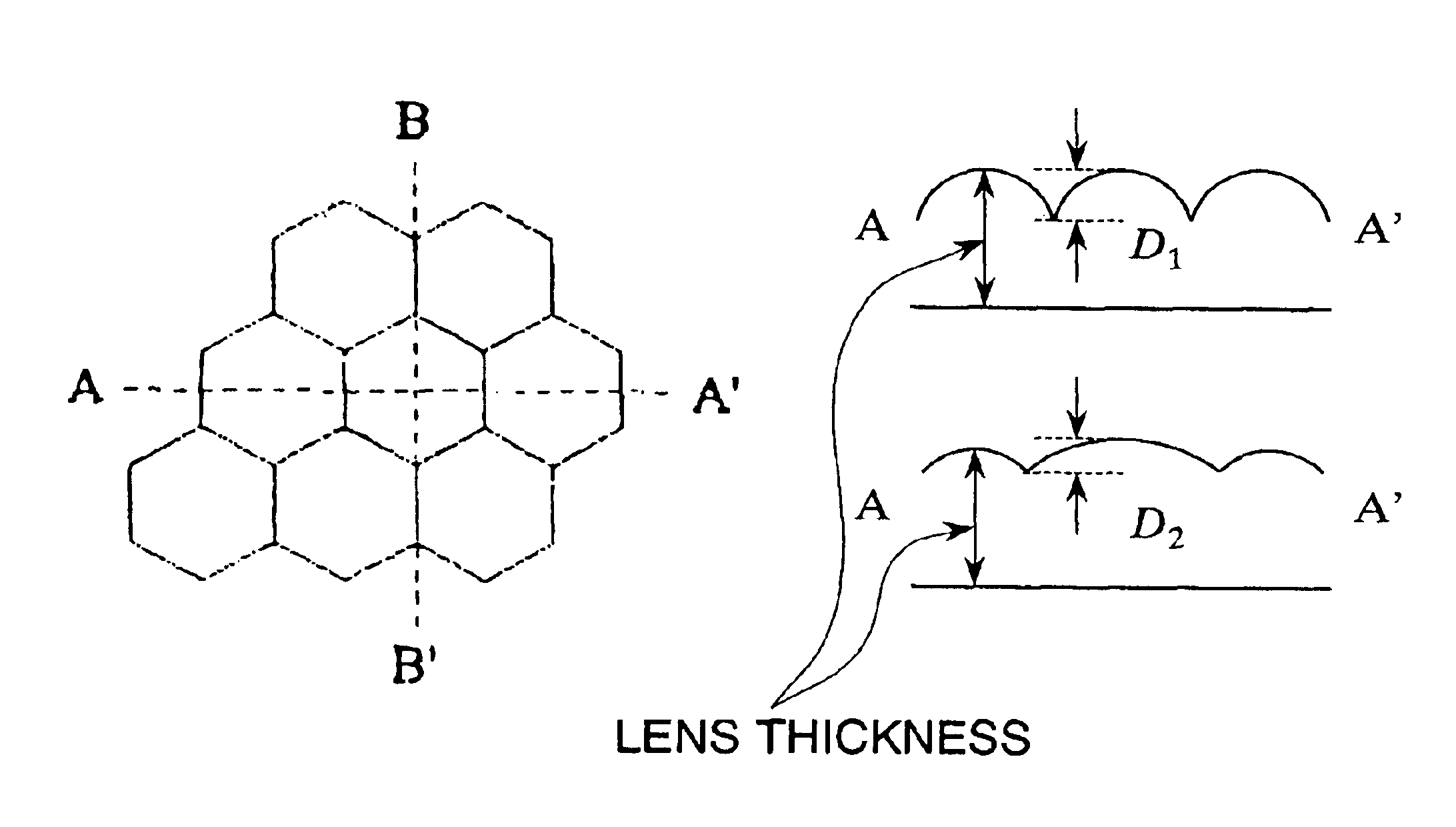Micro-lens sheet and projection screen
a technology of projection screen and micro-lens, which is applied in the field of micro-lens sheet, can solve the problems of reduced transmission light, difficult selection, and difficulty in controlling the light diffusing characteristics in only vertical directions, and achieves the effects of reducing optical absorption, reducing optical absorption, and forming a fine bm
- Summary
- Abstract
- Description
- Claims
- Application Information
AI Technical Summary
Benefits of technology
Problems solved by technology
Method used
Image
Examples
first embodiment
[0083]FIG. 12 is a cross section showing a general structure of a liquid crystal rear projection television. Reference numeral 31 is a light source lamp. Reference numeral 32 indicates an optical structural section. Reference numeral 33 indicates a liquid crystal panel. Reference numeral 34 indicates a first mirror. Reference numeral 35 indicates a projecting lens. Reference numeral 36 indicates a second mirror. Reference numeral 37 indicates a screen. FIG. 13 is a cross section viewed in A-A section in the screen 37. In FIG. 13, Reference numeral 38 indicates a Fresnel lens. Reference numeral 39 indicates a micro-lens. Reference numeral 40 indicates a black matrix section. Reference numeral 41 is a protection layer. Reference numeral 42 indicates a hard-coat section.
[0084]FIGS. 1A and 1b are cross sections showing a micro-lens sheet 10.
[0085]On one surface of a base board 11, the micro-lens array section 12 made from a reacted product of radioactive-ray-curable-resin is bonded. In ...
second embodiment
[0101]FIG. 5 is a cross section showing an example for a micro-lens sheet 101 according to the present invention.
[0102]On one surface of a transparent supporting member 103, a lens section (unit lens group) 102 is formed by using a reacted product of radioactive-ray-curable-resin. A shading patter (BM) 105 having an aperture in a spot manner is formed in a position corresponding to a non-light-condinsing section by each of the unit lens on a flat surface which is opposite to the transparent supporting member 103 via a positive photosensitive adhesive layer 104.
[0103]For a transparent supporting member 103, polyethylene terephthalate (PET) or polycarbonate (PC) can be named.
[0104]It is preferable that the diameter of the unit lens and its disposition pitch are 200 μm or less so as to obtain a screen which is suitable for observing the fine resolution image.
[0105]Such a fine pitch operation can be obtained by performing a molding operation for forming a lens according to 2P method (ph...
third embodiment
[0121]Embodiments of a projection screen as an example for the present invention is explained as follows with reference to the drawings.
[0122]FIGS. 8A and 8B are general views for an element lens of a micro-lens sheet used in a projection screen according to the present invention.
[0123]FIG. 9 is a perspective view of an element lens contained in the micro-lens array sheet used in the projection screen according to the present invention.
[0124]FIG. 10 is a cross section of an element lens in a vertical direction contained in the micro-lens array sheet used in the projection screen according to the present invention.
[0125]FIG. 11 is a cross section of an element lens in a horizontal direction contained in the micro-lens array sheet used in the projection screen according to the present invention.
[0126]Here, regarding the lens array sheet shown in this embodiment, the shape of the lens are actually designed, and these drawings are made according to these designed lens shape.
[0127]In FIG...
PUM
 Login to View More
Login to View More Abstract
Description
Claims
Application Information
 Login to View More
Login to View More - R&D
- Intellectual Property
- Life Sciences
- Materials
- Tech Scout
- Unparalleled Data Quality
- Higher Quality Content
- 60% Fewer Hallucinations
Browse by: Latest US Patents, China's latest patents, Technical Efficacy Thesaurus, Application Domain, Technology Topic, Popular Technical Reports.
© 2025 PatSnap. All rights reserved.Legal|Privacy policy|Modern Slavery Act Transparency Statement|Sitemap|About US| Contact US: help@patsnap.com



